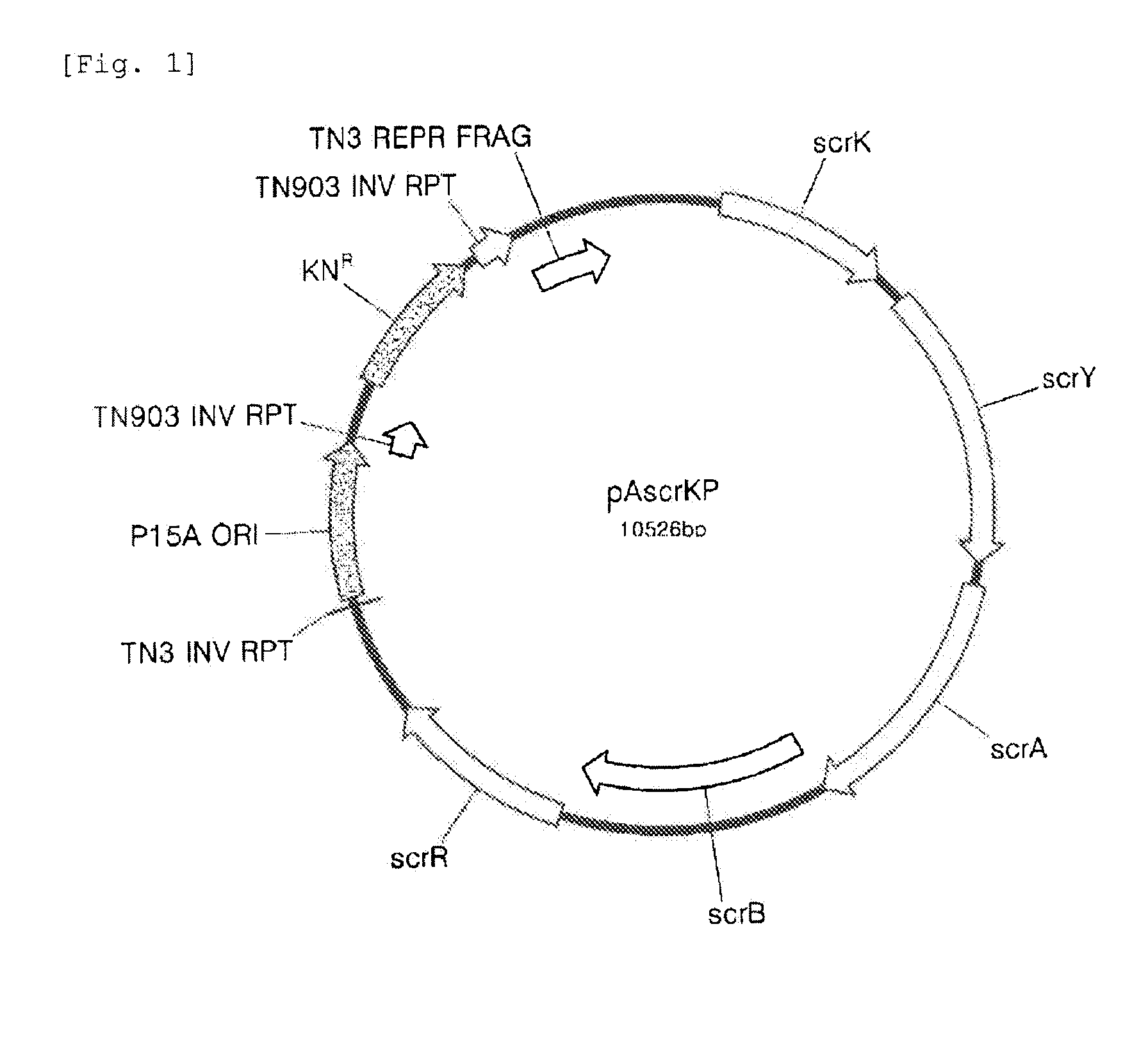Microorganism Which Produces L-Amino Acid and Method for Producing L-Amino Acid Using the Same
a technology of microorganisms and amino acids, which is applied in the field of microorganisms, can solve the problems of rapid increase in the price of starch sugar mainly used in industrial fermentation, and achieve the effect of reducing the price of starch sugar
- Summary
- Abstract
- Description
- Claims
- Application Information
AI Technical Summary
Benefits of technology
Problems solved by technology
Method used
Image
Examples
example 1
Cloning and Identification of Sequence of Scr Regulon which is Involved in Sucrose Assimilation
[0045](1) Cloning of Sucrose Assimilative Microorganism-Derived Scr Regulon
[0046]To impart a sucrose assimilability to a sucrose non-assimilative Escherichia sp. microorganism, the gene cluster involved in sucrose assimilation, scr regulon was obtained from a sucrose assimilative microorganism. The scr regulon is composed of five genes, scrK (fructokinase), scrY (sucrose porin), scrA (sucrose-specific EIIBC component), scrB (sucrose-6-phosphate hydrolase), and scrR (LacI-related sucrose-specific repressor), and two operons, scrK and scrYAB are negatively controlled by the ScrR repressor (Mol, Microbiol. (1993) 9:195-209).
[0047]The Scr-PTS system, scrKYABR genes were obtained by PCR (Polymerase Chain Reaction) using each chromosome of Klebsiella pneumoniae (ATCC700721D-5) and Erwinia carotobora (ATCCBAA-672D) purchased from American Type Culture Collection as a template. The scrKYABR gene t...
example 2
Construction of Sucrose Assimilative, L-Amino Acid Producing Microorganism
[0054](1) Transformation with Recombinant Plasmid
[0055]In order to examine whether a threonine-producing E. coli grows using sucrose and produces threonine efficiently, when the E. coli is transformed with each of the gene cluster involved in sucrose assimilation, scr regulon-containing pAscrKP (SEQ ID NO. 17) and pAscrEC (SEQ ID NO. 18) obtained in Example 1, each of the plasmids was introduced into coli ABA5G by a typical transformation method. The E. coli ABA5G transformed with pAscrKP or pAscrEC was spread on a MacConkey agar plate containing 1% sucrose. Of colonies, deep purple colonies were selected. PCR was performed to confirm that the selected colonies had the sucrose assimilation related gene-containing plasmid.
[0056](2) Production of Threonine by a Microorganism Transformed with pAscrKP or pAscrEA
[0057]The colony obtained in (1) was cultured on a LB solid medium (1 g of tryptone, 1 g of NaCl, 0.5 g / ...
PUM
| Property | Measurement | Unit |
|---|---|---|
| time | aaaaa | aaaaa |
| temperature | aaaaa | aaaaa |
| temperature | aaaaa | aaaaa |
Abstract
Description
Claims
Application Information
 Login to View More
Login to View More - R&D
- Intellectual Property
- Life Sciences
- Materials
- Tech Scout
- Unparalleled Data Quality
- Higher Quality Content
- 60% Fewer Hallucinations
Browse by: Latest US Patents, China's latest patents, Technical Efficacy Thesaurus, Application Domain, Technology Topic, Popular Technical Reports.
© 2025 PatSnap. All rights reserved.Legal|Privacy policy|Modern Slavery Act Transparency Statement|Sitemap|About US| Contact US: help@patsnap.com

